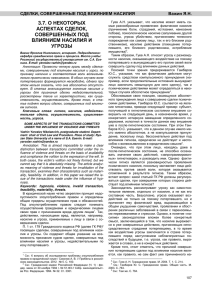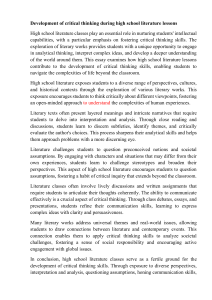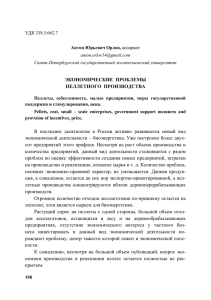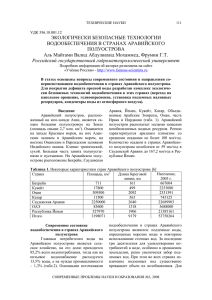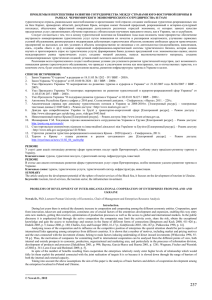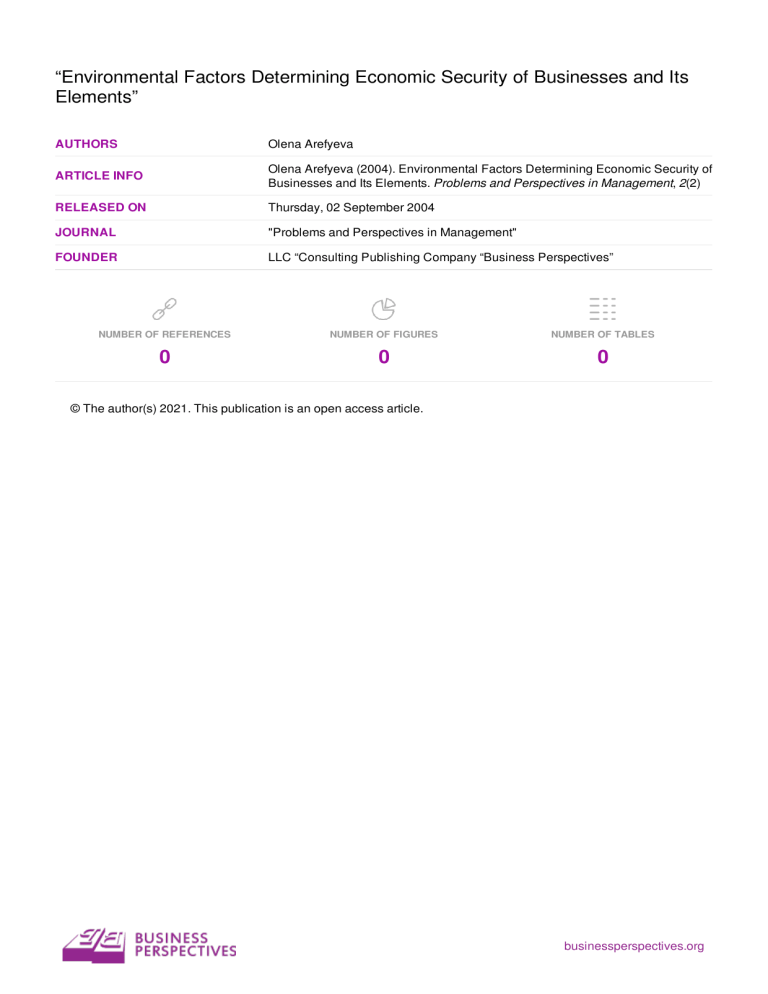
“Environmental Factors Determining Economic Security of Businesses and Its Elements” AUTHORS Olena Arefyeva ARTICLE INFO Olena Arefyeva (2004). Environmental Factors Determining Economic Security of Businesses and Its Elements. Problems and Perspectives in Management, 2(2) RELEASED ON Thursday, 02 September 2004 JOURNAL "Problems and Perspectives in Management" FOUNDER LLC “Consulting Publishing Company “Business Perspectives” NUMBER OF REFERENCES NUMBER OF FIGURES NUMBER OF TABLES 0 0 0 © The author(s) 2021. This publication is an open access article. businessperspectives.org Problems and Perspectives in Management, 2/2004 205 Environmental Factors Determining Economic Security of Businesses and Its Elements Olena Arefyeva1 The activity of economic agents in emerging market relations requires a rapid determination of factors conditioning the availability of economic security of businesses, adaptation to dynamics of external environment through liquidation of existing threats. The establishment of market economy foundations leads to competition between the market players, which, in its turn, is a source of risk. Therefore, economic security management can be considered as an inherent part of the system of business management aimed at standing up against internal and external risks of its performance. Taking safeguards to provide for enterprise’s security is necessary to protect its activity from negative effects of external environment and support a condition of the most effective use of all types of resources to prevent threats and provide for stable situation and stable operation of the business at present and in the future. With the aim to work out timely administrative decisions, it is appropriate to determine factors conditioning economic security of businesses. Studying literature dedicated to this problem allows us to draw a conclusion about ambiguity of experts’ opinions concerning the number of factors, their structure and significance. Most economists identify factors contributing to business crisis as such that contribute to bankruptcy. Among them the following authors, such as L.O.Ligonenko, G.Abdul and T.A.Istomina should be mentioned. They consider that studying the key factors economic security of the business, that cause the crisis development of an enterprise, is a conclusive stage of bankruptcy diagnostics. Since factors conditioning a crisis development of the enterprise are, at the same time, a format for realization of certain types of financial risks and threats. The aforementioned factors can be divided into two main groups: a) independent from business activity (external or exogenous factors); b) dependent on business activity (internal or endogenous factors). The crisis development external factors, in their turn are split into three following subgroups: 1. Social and economic factors of the overall country’s development. Only these factors influencing the economic performance of a certain business (i.e. factors shaping the potential for bankruptcy risk) make the subject for consideration. 2. Market factors. When considering market factors, tendencies of development negative for this business in terms of commodity (including raw materials and manufactured goods) and financial markets (money, stock and foreign exchange) are under study. 3. Other external factors. The enterprise itself determines these factors’ structure with taking into account the specific character of its economic performance. In the course of the crisis development analysis, internal factors are also divided into three following sub-groups depending on money flows peculiarities, namely: factors related to manufacturing operation; factors related to investment activity and factors related to financial activity. This approach is comprehensible, since management did not pay enough attention to economic security of businesses during the period of economic transition in Ukraine, which resulted in the fact that many domestic enterprises found themselves in crisis. Among the main causes, the following should be mentioned: firstly, high prime cost of production and the lack of demand for it, which led to an emergence of the great number of loss-making businesses. In 2001, loss-making businesses made 43% of the total number of enterprises. Secondly, in 2001, accounts payable made UAH 258401.8 mln and accounts receivable UAH 185277.6 mln respectively; almost half of them were overdue. As a result, many businesses are insolvent and bankruptcy cases are brought to court. Nearly five thousand bankruptcy or debtor’s solvency recommencement cases were brought 1 Doctor of Economics, professor of European University 206 Problems and Perspectives in Management, 2/2004 to court only in 2001. Almost 50% of cases resulted in liquidation of businesses, 1% – endorsement of a rehabilitation plan, 6% – amicable agreement, 7% – meeting creditors’ requirements; the rest of the cases are closed without any consideration or under other grounds. With the view to bar from a crisis situation, a system of businesses’ economic security should be worked out S. Glushchenko elaborated another approach to determination of business’ economic security; he directly associates businesses economic security with financial risk management [1]. Financial risk management is a process with the help of which the economic agent influences the risk situation by making rational changes in the level of business’ economic security in order to provide for a required level of profit. Business’ economic security allows the enterprise to effectively operate in risk situation. The indicator of business’ economic security can be defined as a level of immunity of all the systems of the enterprise in pursuing economic operation under risk situation. The situation is a totality of factors creating conditions for making a decision and implementation of a specific type of economic activity at some specific moment. Ensuring business’ economic security is related to the following: management and staff security; security of culture; security of information and decision-making; manufacturing security; legal security; financial security; espionage security. Management and staff security means physical security of life and health for senior, middle, and junior management and executive staff. Security of culture is related to relations between the employees within the organization, between the organizations in the person of management and the staff, relations with external cultures (with the culture of clients and territories where the enterprise or its units are situated). Security of information and decision-making covers keeping of know-how, scientific researches and innovation elaborations, economic extension plans by limiting access for outsiders to market confidential information. Manufacturing security provides for protection from negative effect on buildings, constructions, equipment, manufacturing technology, raw materials, materials, semi-finished production, as well as providing for a possibility to diversify production manufacturing, re-orient to another suppliers, rapid technical re-equipment in case of its including to a new production manufacturing. Legal security per se is aimed at keeping available patents and obtaining new ones, licenses, authorizations; preventing or bringing to a minimum penalties, fines, forfeits and responsibility for violation of existing legislation. The aim of financial security is to provide for a quality budgeting, reduction of tax burden, the inflow of required investment and obtaining profit. F.Yevdokimov considers ensuring of business’ economic security as a process of forestalling various losses from unfavorable factors in all areas of its manufacturing and financial activity. Both internal and external factors can produce negative effects: subjective and objective ones. The state legislative and legal system, regulating the country’s economic and social development as well as its security, is an external factor that influences business’ economic security. Technical and economic security (manufacturing potential of an enterprise, timely renovation of production funds, level of production capacity development), resources’ security (supporting manufacturing process with main types of resources, energy), financial security (level of profitability, market share, access to loans, money liquidity, exchange value of securities, optimum capital structure), intellectual and personnel elements (maintaining the staff’s high level of qualification), security of information (establishment of the system of economic support for decisions on economic security), social safety net (level of wages, structure of family incomes, enterprise’s status) are among the areas of enterprise’s economic activity that provide for its economic security. E.A. Oleynikov considers internal environment as the main source for ensuring business’ economic security (BES); he identifies the functional elements of BES as a totality of main areas of enterprise’s economic security that substantially differ from each other by their contents [2]. A general scheme of main areas of BES is shown in Figure 1. Problems and Perspectives in Management, 2/2004 207 Having at their disposal the actual (current) meaning of the level of economic security and for the purpose of its future planning, the enterprise’s management (managers and chief experts) should establish a number of functional elements to envisage the possible threats and to be able to minimize the losses arising in the process of calculations. Financial security Intellectual security Technical and technological security Political and legal safety Labor safety Business’ economic security Resources’ security Security Security of information Social safety net Ecological security Fig. 1. General scheme of main BES elements [2, p.109] It is appropriate, in our view, to determine factors of business’ economic security based on their rating and to split them into two groups: x External factors: a change in the form of property, a change in priorities of the state concerning industrial policy, a change of environment (consumers-suppliers), reduction of production and consumer’s demand as well as internal market reduction, credit system, lack of access to development resources, lack of stability of legislative framework and tax system, unemployment growth, international competition; x Internal factors: ineffective management and marketing, low level of use of all the types of resources and fixed assets in particular, ineffective structure of assets, growth of accounts receivable, scanty stock and its non-competitiveness (Figure 2). It is evident that the level of economic security is based on efficiency of this enterprise’s offices in preventing threats and eliminating losses from negative impacts on the different aspects of economic security. The sources of such negative impacts can be deliberate and non-deliberate actions of people, organizations, including state authorities, international organizations or rival businesses; negative impacts can also be a result of coincidence of objective circumstances, such as the financial market state, scientific discoveries and technological developments, force major circumstances, etc. According to their subjective conditionality those negative impacts can be divided into the following categories: Objective negative impacts – are those that emerge without involvement and in spite of the will of an enterprise or its employees. Subjective negative impacts emerge because of ineffective work of the enterprise in general, or its employees. A substantial difference should also be noted between the factors that cause a crisis and those that contribute to business’s economic security. The crisis can be called forth by the lack of financial discipline, poor management, bad technologies, and non-competitive production, which are actually the results of negligence and the 208 Problems and Perspectives in Management, 2/2004 lack of the system of business’s economic security. Whereas achieving business’s economic security means pursuance of purposeful actions to avoid negative tendencies in the development of an enterprise, which, in its turn, allows the company to comply with the interests of economic agents, employees, creditors, state and society. There are also differences between managing factor mechanisms. Therefore, crisis (bankruptcy) is addressed by means of economic and legal measures; whereas economic security, in most cases, is a result of economic, organizational and technical order. Within economic environment, businesses, generally, work in close contact with other structures. Consideration of their economic security factors and their market status is possible only within its interaction with other objects. Consequently, the main elements of threat to business’ economic security (within Ukrainian market) are the following: 1. Elements of the state economic security are as follows: reduction of science-based production; lack of developed banking and insurance system, as well as guarantees from trust organizations; state budget deficit; the outflow of capital; high taxes on producers; low level of economic statistics credibility; weak law enforcement agencies and mass media; poverty and misery of the majority of population; strikes. 2. Elements of regional economic security are as follows: lack of legislative framework that regulates the rights and duties of the regions; lack of the regional banks network; failure to change local taxes and charges; failure to compile a free regional financial balance sheet; lack of economic infrastructure or its insufficient level of development; unsatisfactory level of managerial staff qualifications; mass media; documentation circulation, information and reporting; control and revision bodies; unsatisfactory awareness of population of the essence of economic reforms and unsatisfactory instilling into the minds of population the idea of their being masters of the region and, by and large, of the state. 3. Elements of business’ economic security are the following: availability of legislative framework and its enforcement; methods of economic regulation on behalf of the state (in the first turn, tax policy and taxation system); level of the state intervention into economy, marketing system preparation; unsatisfactory level of personnel training; mass media; documentation circulation, information and reporting; control and revision bodies; negotiating with clients; issues of technical and physical security of enterprises and entrepreneurship. When examining the issue of economic security, it is possible to conclude about the necessity of a comprehensive approach. Until now, there is a lack of a single view on the comprehensive systemic approach to ensuring economic security of objects, functioning security services, their mutual interaction and their interaction with law-enforcement bodies. The majority of senior managers still fail to understand the principle of ensuring security as one of the basic elements in economic activity. Therefore, the issue of economic security is often treated as a secondary one. In our view, the principles of business’ economic security should include the following components: the priority of warning measures – non-admission of emerging real threats; legitimacy – actions within the framework of existing legal acts; comprehensive use of forces and means to develop program on complex ensuring of security; coordination and interaction within the enterprise – safeguards against threats are implemented on the basis of concerted efforts of all units; combination of disclosure with conspiracy – awareness of the staff about security safeguards within permissible limits; competency – security issues should be addressed by professionals; economic feasibility – costs should not exceed the optimum level; activity planning – security activity should be based on a comprehensive security program; systemic approach- i.e. taking into account the whole range of factors influencing security. Factors of business’ economic security Financial and investment factors Irrational structure of capital Availability of lucrative investment projects Purchasing power Availability of test and evaluation work Level of entrepreneurial risk Internal factors Normative and legal factors System of contracts with counteragents Availability of executive instructions and provisions System of informational software Fig. 2. Factors contributing to business’ economic security Staff and management factors Availability of development strategy Management relevant to market Personnel qualifications Personnel motivation Management organizational structure Marketing and commercial factors Production and services order portfolio Price policy Marketing studies Availability of diversification Advertising planning 209 Other factors Non-stable political situation Growth rate of scientific and technical progress Level of competition Negative demographic tendencies Natural and man-made disasters External factors Market factors Production and consumers’ demand Level of prices on raw materials and finished production Bankruptcy of counter-agents Competitors’ solvency Reduction of the internal market volume Production and operation factors Use of fixed assets and working capital Structure and liquidity of assets Production profitability Implementation of new technologies Structure of the prime cost Level of constant spending Level of insurance reserves Problems and Perspectives in Management, 2/2004 Macroeconomic factors Crisis phenomena in economy Legislative framework stability Inflation processes Purchasing power Level of unemployment Level of financial system development State policy (Industrial, financial, social, tax, and credit) 210 Problems and Perspectives in Management, 2/2004 The afore-mentioned principles can be also supplemented by the principles of management system functioning within safe functioning of an enterprise, proposed by A.V.Kiriyenko [7]. They are the following: unconditional meeting of general needs of the enterprise and its employees, flexibility of economic potential structure, which provides for its stable functioning at present and safe activity in the future; capability of management to rapidly react on threats and effectively use the existing possibilities as well as reliable and accurate informational support for planning and use of business’ strategies, public awareness of the necessity of creating favorable conditions for an enterprise to provide for its own security measures. An assessment of economic security is very important for industrial enterprises, since their active operating potential is a determining stability factor in anti-crisis development, and is a guarantee for economic growth and country’s economic independence and security. The status and tendencies of development ensuring economic security of businesses exclude or minimize the damage not only to the potential of one isolated enterprise but also to the economy as a whole. Consequently, it is the main function of ensuring economic security. One of the pivotal tasks of effective modern management of ensuring economic security has the following features, namely: stable eagerness to increase production effectiveness; broad economic independence that allows for a decision-making will; ongoing adjustment of goals and programs depending on market situation and external environment; orientation at achieving conclusive results of enterprise’ planned activity; use of modern information software for various calculations when making managerial decisions; change in planning – from current to perspective; laying special stress on all main factors to improve business performance; management assessment on the basis of real conclusive results; maximum use of calculus methods and computer data; involvement of all company’s employees in management; execution of management on the basis forecasting changes, taking flexible decisions, implementation of innovations, introducing innovative approach in every aspect of enterprises’ activity, taking non-standard decisions, pursuing indepth analysis of every managerial decision; capability to take reasonable risks, ongoing training and improving qualifications; acquiring a key role for marketing. References 1. 2. 3. 4. 5. 6. 7. Gluschenko S. Financial risk management and economic security of businesses. Edition 4, p. 22-29 Oleynikov E.A. Economic security foundations. – M., 1997, 260 p. F.I.Yevdokimov, N.V.Fedorova. Business’ economic security assessment and planning// Courier of the technical university, Podillya, 2000. — No. 4. – P.2 – p. 108-110 Podluzhnaya N. A choice of business’ economic security criterion, collection of scientific studies, DonNTU, 2002, Edition 47, p. 10-16 Kholod Z.M., Shtangret A.M. Methodological aspects of anti-crisis management// Industrial economy. — Donetsk: Institute for Industrial Economy of the National Academy of Ukraine. — 2002. — No.2.- p. 23-27 Ligonenko L.O. Kyryyenko A.V. A concept of enterprise’s secure functioning: main provisions. According to the materials of an All-Ukrainian conference:” Administration in transitional society on the turn of the XXI century// Personalia. — 1999. — No. 4 (52). — p. 97-101

